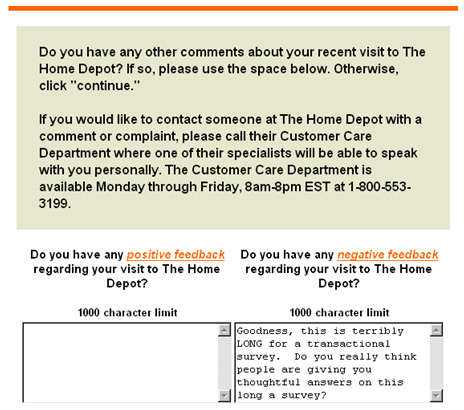Complaint Identification: World Class CRM Surveys
The most important part of a customer satisfaction survey, arguably, is not even part of the survey. It’s what you do with the survey data that creates — or destroys — the value of the survey program. Don’t misconstrue my message. Good questionnaire design and unbiased survey administration are vital, and doing a mediocre job with those survey project elements will lead to poor or misleading data, but will they lead to customer dissatisfaction? Doubtful.
However, ignoring the message inherent in the survey feedback can fuel the fires of an already displeased customer. And sometimes that message isn’t buried subtly in a bunch of number but screams in plain black-and-white text. My recent experience with a Sears customer service and the subsequent IVR survey of theirs I took illustrates this gross mistake.
Survey programs should not be treated as an island in the sea of customer relationship management. If I may torture the metaphor a bit more, land bridges are needed tying all the elements of a CRM strategy together. A customer satisfaction survey is part of this network, but too often they are done in isolation.
Consider the typical goals of a customer survey program.
- Learn where you’ve performed badly so that you can correct those mistakes. (Hopefully, also you want to know where you’ve performed exceptionally well so that you can replicate those strong points.)
- Linked to the above, you want to measure individual performance to identify training needs and also likely to reward the good performers — and punish the bad.
- Identify shortcomings in operational processes and designs that aggravate customers.
- Develop trend lines of performance so that the impact of new operational initiatives can be measured.
- Identify specific customers with issues to allow engaging in service recovery assuming it’s not an anonymous survey.
For some bizarre reason the last goal is frequently missed. If not recognized, then your survey program has a huge downside risk. In a transactional survey program which are almost never anonymous, this risk is magnified since the customer just had the experience with you and the displeasure — or anger — is quite high.
Imagine this scenario. A customer completes a transactional survey with low scores and highly critical comments in the open-ended text fields. As the owner of the survey program, what should you do? Home Depot’s approach in its transactional store visit survey is to tell customers you can enter comments here, but if you really want someone to read them, then call this number. In the customer service world, we call this a “cold transfer.”

Here’s a better idea: ignore them! And that’s what many companies do. Read about my Sears customer survey experience for the best of the bad practice in this area.
What should you do? Recognize the interconnected nature of all elements of a CRM strategy, and that a survey program is one element in that strategy. Any customer survey, but particularly a transactional survey, should include a “hot sheet” function where surveys with negative scores and/or comments are routed immediately to a manager for response. In a telephone survey environment, the interviewers should provide a “hot transfer” of the customer, that is, transfer the customer to a customer service agent introducing the customer to the agent with a brief explanation, or with a “warm transfer” where the agent dials the number but does no introduction.
Hot sheets and warm or hot transfers still aren’t enough. You need to have a service recovery program implemented concurrently with the survey program. Many companies launch a survey and then find themselves in crisis mode reacting to customer issues presented in the surveys. Or worse, the companies just ignore the cries for help evoked in its surveys — as Sears does.
The goal of a survey program is to increase customer satisfaction, right? Isn’t it only logical to put all the tools in placed needed to positively effect customer service? Then why isn’t it done universally? Only two reasons exist: 1) ignorance, or 2) a total disregard for the customer.
